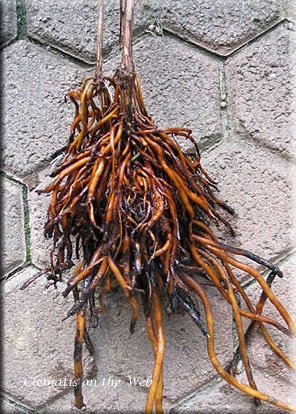Root rots
Types affected
1. The roots of Atragenes and C. montana may be attacked by the fungus Rhizoctonia solani . Visible symptoms are a wilting of the leaves. Roots turn brown and show little new growth. The disease is prevalent in soils which are compacted or waterlogged.

Symptoms of Rhizoctonia root rot
2. The roots of small-flowered clematis such as C. armandii can be attacked by several Phytophthora species. These soil-borne fungi are predominant in very wet soils. The young root tips are infected which turn black and plants decline, often resulting in death.

Symptoms of Rhizoctonia root rot
3. Information about damage caused by the wilt fungi to the roots of large-flowered clematis is sparse. Phoma clematidina has been isolated from black lesions of wilted and non-growing plants in nurseries and has been shown to be capable of infecting and causing these symptoms on C. ‘Henryi’ (P. van de Graaf, PhD thesis).
As described in the page on Wilt, a root rot may be involved in the decline of old large-flowered clematis plants which have been attacked by wilt. In this example, the responsible fungus was not identified but could be one of the wilt fungi or Rhizoctonia.

A 20 year-old C. ‘Lasurstern’ in decline showing root rot

Detail of root rot symptoms
Control methods
Root diseases usually go unnoticed until they have progressed to such a stage that the plant becomes so weak that it has to be dug out. The roots of any plant which has declined for unknown reasons and has had to be dug out should be checked for symptoms. The idiom ‘out of sight, out of mind’ is very relevant. Replanting similar clematis types on the same spot should be avoided.
Ensure that the site chosen for planting clematis is not subject to compacting, waterlogging or excessive drying out. Prepare the site well, adding supplements such as organic matter to create a good soil structure. Buy plants from a highly reputable source so that you start with healthy material.
Text ©2007 Paul Margot